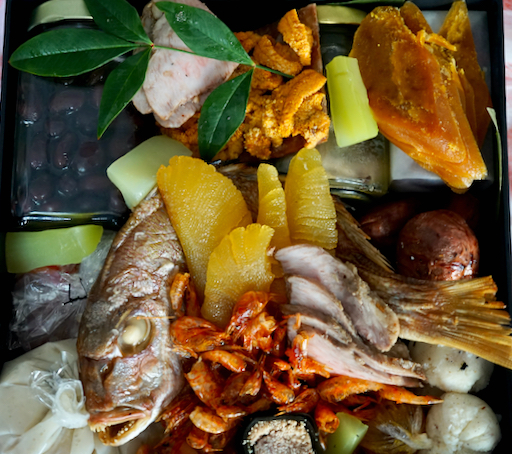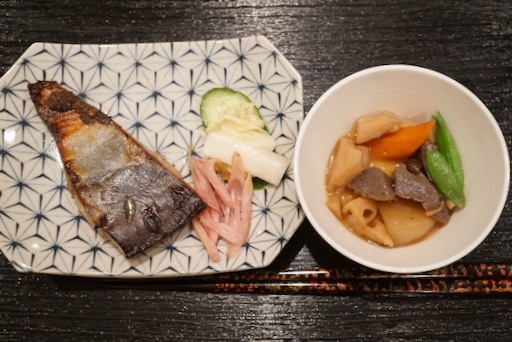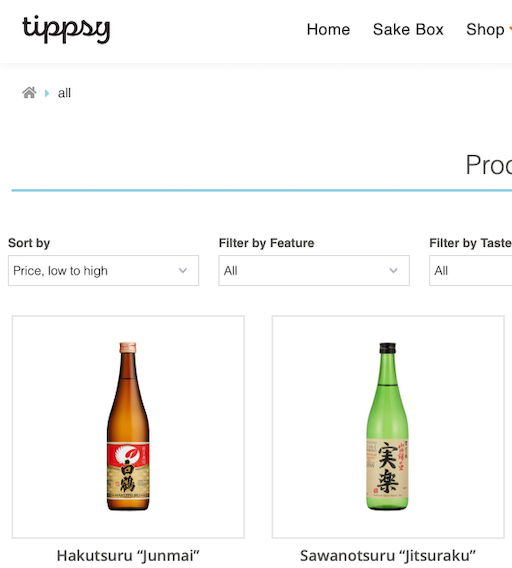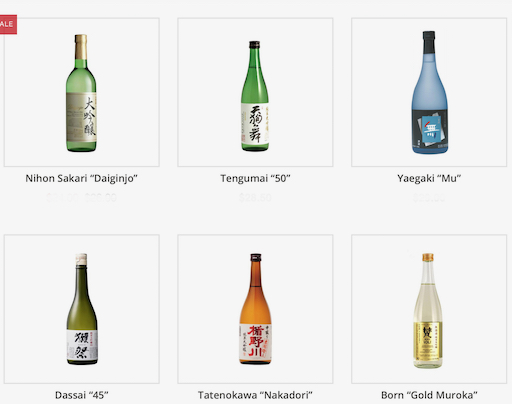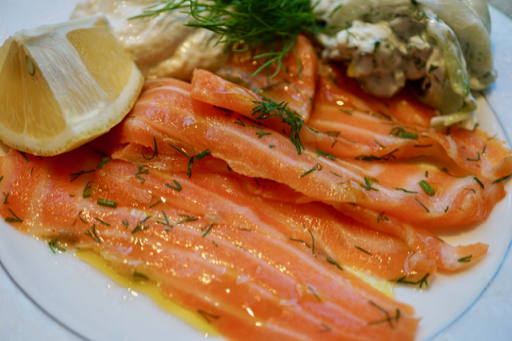Thursday, December 7, 2023
Electric Sake Warmer 電気酒燗器
We bought it at Amazon but it came from a seller in Japan. The sake warmer sits on top of the heating unit. The server holds about 240ml (1号半). It heats up to the specified temperature in10-15 minutes. The temperature control is continuous (not discreet steps) and ranges from about 35C to 60C (95F to 140F). Using my digital thermometer and water, the actual temperatures are higher (by about 5-10F) than it indicated. We usually like “Atsu- kan” *.
*ranges of warm sake temperature
“Jouon” 常温, room temperature 20℃ (68F)
”Hinata kan” 日向燗 sunny side 30℃ (86F)
”Hitohada kan” 人肌燗 skin temperature 35℃ (95F)
”Nuru kan” ぬる燗 luke warm 40℃ (104F)
”Jou kan” 上燗 warm 45℃ (113F)
”Atsu kan” 熱燗 hot 50℃ (122F)
The sake warmer works extremely well. We can have it sitting next to us and as we are enjoying the warm sake, we can add more sake to the server. By the time we are ready for the next serving, the sake has reached the proper temperature. The only challenge is to warm up enough but not too much sake and to consume it at just the peak of time it has been warming. This is because any leftover sake once heated will not be good the next day for example. Also,warming up the sake and keeping it warm more than 1 hour is not good either. In any case, this was a great improvement break through. We are glad that we can now enjoy Tengumai junmai sake this way. So the mistake which had us end up with a case of tengumai-junmai instead of our favored house sake was indeed a “blessing in disguise”. It introduced us to a sake variation which we now enjoy but would never otherwise thought of trying.
Wednesday, January 4, 2023
New Year’s day Evening 元旦の夕べ
So finally, we busted into the osechi box for the New Year’s day evening feast. Like we did before, I decided to use “Tsugaru-muri” 津軽塗り lacquerware two-tier lunch box (one tier for each of us) to serve the goodies. As a side, I also served the diakon-namasu 大根なます I made topped with slices of boiled Spanish octopus leg we got from D’Artagnan and Ikura salmon roe.
I picked up most of the key items here including our favorites like “kazunoko” herring roe marinated in miso かずのこの味噌漬け, “karasumi” 唐墨 botargo and “ankimo tofu” あん肝豆腐 monkfish liver terrine. I lightly toasted karasumi, duck breast and “sawara saikyo-yaki” 鰆の西京焼き before serving.
These small items were such a treat. We enjoyed every bite along with a sip of our house sake “Tengumai daiginjo” 天狗舞大吟醸.
Tuesday, August 9, 2022
Watari bune Daiginjo 渡船純米大吟醸
This sake “Watari bune, junmai daiginjo” 渡船純米大吟醸 was a gift from a friend for a recent occasion. This is a really great sake with a slightly effervescent feel and fruity, crisp but very complex flavors. This should definitely be drunk cold. This sake is brewed by “Fuchu-homare” 府中誉 which is located in Ibaragi prefecture 茨城県. The sake rice or “sakamai” 酒米 used for this sake is also called “Watari bune” which is supposedly a very rare near-extinct sake rice which relatively recently has been revived. The famous and most popular sake rice “Yamada nishiki” 山田錦 is reportedly a descendant of this rice. Also the name “Watari bune” 渡船, which means a “ferry” or “ferryboat”, is very fitting for sake from Ibaragi which is known for Tone river 利根川 and its estuaries criss crossing the flat delta before pouring into the Pacific ocean.This area also contains large lakes. (Such areas rich in water ways and lakes are called “Suigou” 水郷). Such topography would require use of ferries i.e. “Watari bune” to navigate the water ways.
Friday, January 7, 2022
Sushitaro Osechi 2022 寿司太郎お節 2020
This is a picture of the upper box. I am not going into the details but its all good stuff. Many items are hidden behind and under the items on the top.
This was what we ate from the box the evening of January 2. I just served whatever caught my eye. This round was mainly items that go well with sake.
In this three compartment plate, I served (from left to right) “Mushi uni” 蒸し雲丹 or steamed sea urchin, “Uni shutou with yuzu-chilli” ウニ酒盗 柚子胡椒 from Maruhide 丸秀 and “ikura shouyu-zuke” いくら醤油ずけ soy marinated salmon roe. I added wasabi-soy sauce to the steamed uni and made a cucumber boat to contain the ikura. All perfect for sake.
After these, we had simmered vegetables (again lightly warmed in the microwave) and finished with a mayo-biscuit my wife made that afternoon (subject of another post).
Sunday, December 5, 2021
Hiyaoroshi #2 and Uni tasting 冷やおろし#2、海水うに
This is a continuation of our exploration of the “Hiyaoroshi” sake ひやおろし we recently acquired (with a complementary uni tasting on the side.) As I mentioned before, this sake is seasonal; only available in autumn and until recently, the only way to enjoy this seasonal sake was to visit Japan in autumn. This fall, however, thanks to Tippsy sake, we could enjoy hiyaoroshi here in U.S. So far, we’ve tried 5 different hiyaoroshi sakes. All of them were “Junmai” class but the aging process really “kicked them up a notch” making them taste superior to regular Junmai sake. All the hiyaoroshi we tasted had rich savory and complex flavors with some fruity floral characteristics. We tasted (from left to right) three sakes; “Ooyama”, “Gokyo” and “Kisoji”.
1. Ooyama 大山 (meaning “big mountain”) is from Yamagata prefecture 山形県 (which is famous for many excellent and “cult” sakes including “Juyondai” 十四代). The brewery is “Katou Kahashirou” 加藤嘉八郎酒造. This sake is called “Tokubetsu junnmai” 特別純米. “Tokubetsu" means “special”. My understanding is that this designation does not have an official definition, but usually the rice is polished to 60%. This is the same level of polishing as “Ginjou” 吟醸酒. So, by definition, this type of “Tokubetsu junmai” could also be sold as “Ginjo”. It is up to the brewer to decide what to call it. Junmai is usually characterized by robust and rich flavors while ginjo is characterized by more elegant crisp fruity flavors. So, depending on the aim of the particular sake, the brewer could call it either way. We really like this sake. Quite rich and dry with some acidity.
Saturday, November 13, 2021
Hiyaoroshi sake ひやおろし
When we traveled to Japan, we ususally chose late spring early summer to avoid the rainy 梅雨 and typhoon 台風 seasons. We could not handle the heat and humidity of summer months. Over the years, we made some exceptions. We visited Japan once in winter to attend New Year with my family and twice in late September and October just barly evading typhoons (in 2013 and 2017). It is nice to visit Japan in fall, since it is the harvest season with great produce especially fruits and vegetables. Seeing golden rice paddies at sunset from the Shikansen is something to remember. In addition, we could enjoy seasonal sake only available in the fall which is the main point of this post.
In 2013, we visted “Tako Grill” in Kuroishi 黒石, Aomori 青森. Chef Kudo 工藤 opened this Japanese Tako Grill after he left “Tako Grill” in Bethesda and went back to his home town in Japan. When we visited, he served us local Kuroishi sake “Kikunoi Akiagari” 菊乃井 秋あがり. We really liked this sake. We liked it so much Chef Kudo had to send a waitress out to get more from the brewery since we drank what he had at hand.
The “Hiyaoroshi” 冷やおろし or “Akiagari” 秋あがり is a seasonal sake and is only available in the fall. My undestanding is that the sake is brewed during the winter and bottled in the spring. It is pasturized or “hi-ire” 火入 and then stored in a cold environment until fall when outside temperatures get cold. Up until now we thought the only way we could enjoy “hiyaoroshi” was to go back to Japan in the fall. Now, we discovered we can get “hiyaoroshi” sake in the U.S. from Tippsy sake. Recently we got two hiyaoroshi from them; one is “Otokoyama” from Asahikawa, Hokkaido 男山、旭川 (right) and Koshi-no-homare from Niigata 越の誉, 新潟 (left). Both are junmai class sake.
We first tasted "otokoyama" (meaning "manly mountain") . The label shows what looks like baby seals drinking sake. (We momentarily contemplated whether this image suggested under-age drinking…by seals)? This is a very nice sake. Although it is "tokubetsu junmai", it does not have any yeasty smell/taste but is rather dry with rich complex flavor and some fruitiness up-front. We had this with imitation negitoro and it went very well.
Although we tend to favor "Otokoyama" (and that is not just because I am from Hokkaido), we are very happy with either one. It is so nice that Tippsy sake brought "hiyaoroshi" sake to U.S.
Wednesday, April 7, 2021
Senkin Muku Modern 仙禽無垢モダーン純米大吟醸無濾過
I have not done a post just about sake for a long time but this one is worth a special post. This is called "Senkin Muku Modern Junmai daiginjou" 仙禽* 無垢 モダーン 純米大吟醸 from Senkin sake brewery from Sakura city in Tochigi prefecture 栃木県さくら市. The sake rice is Yamada-nishiki 山田錦 from the local area. According to their website, they emphasize "Domaine" like French wineries, making sake reflecting their “terroir” 風土, water 水, rice 米, and brewery 蔵.
Sunday, November 29, 2020
Yellowtail marinaded in sake lee ハマチの粕漬け
This was the last of the whole fresh yellowtail. I marinated the filet in sake lee 酒粕 or "Kasu-zuke" 粕漬け. Since I did not have a time to cook this during the week, the fish marinated for a week which was a bit too long. I also made Japanese stewed vegetable "nituske" 煮付け as a side.

Ingredients:
Sake lee 300grams
Red miso 30grams
Sugar 3 tbs
Salt 1/2 tsp
Sake to loosen up the marinade if too stiff,
Directions:
I added half of the sake lee mixture in the bottom of a sealable container and placed cheese cloth (after washing to remove any lint). I put in the filets and then covered them with another layer of cheese cloth. I put the remaining sake lee mixture on top. I let it marinate in the refrigerator (for a week as it turned out).
This was a bit over-marinated. I started broiling on the flesh side first as shown below in the toaster oven.
Tuesday, October 13, 2020
Special take-out Kaiseki box from Sushi Taro 寿司太郎のテイクアウト特製会席弁当
Prior to COVID the omakase counter at Sushi Taro was our special-occasion-go-to place. As a matter of fact, we had a reservation in March this year but because of COVID, that got canceled. I knew for some time that, although the restaurant was closed, Sushi Taro has been doing take-out. But getting there either from home or work for the pick-up was impractical. Since I started thinking about the NewYear “Osechi” 御節 from Sushi Taro, I contacted them. I was delighted to find out that they are going to do Osechi for the next New Year and I quickly placed an order. During that interaction, I learned that they do special omakase kaiseki boxes-to-go and that they can deliver. I quickly placed an order. Delivery was scheduled for Friday at 5pm. We were like little kids in anticipation. I even "just happened" to come home from work a bit early for the delivery. It arrived in two, two-tiered (bento or modified jubako?) boxes. (a total of four boxes with three compartments each). We initially thought we got two identical sets but when we opened the second box, surprise! We were totally blown away. All compartments contained many wonderful different dishes. The first one had some cooked dishes, two different kinds of sushi. The cooked dishes in the top tier were still warm.
Tuesday, January 28, 2020
Warm sake and oden on a cold winter's evening 厳寒の冬の夕燗酒とおでん
Of course on a cold winter evenings, warm sake is best paired with either oden おでん or nabe 鍋dishes. This time, I made oden. Usually boiled eggs in oden end up hardboiled even if they are soft boiled when put in the broth. So this time I made soft boiled eggs with runny yolks which I kept separate from the rest of the oden, then just 5 minutes before serving I warmed them in the broth. I put mochi in the deep fried tofu pouches or "abura-age" 油揚げ. Instead of regular potato I used "sato imo" 里芋 or taro.
Although the eggs did not absorb the broth's flavor, the runny yolks were nice for a change. The cylindrical item is fish cake stuffed with burdock root or "Kobo-ten" ごぼう天. The rest of the items were tofu, shitake mushroom, blanched broccoli and carrot.
On a cold winter evening, this is very warming and comforting.
Wednesday, January 15, 2020
Tippsy sake; Best sake website
This was all solved when I came across the "Tippsy sake" website last March (disclaimer: I am not associated with or getting any benefits from them except that I can now buy the sake I want on line). I guess when you get "tipsy", your finger hits "p" twice. I have bought 5-6 cases by now and I am happy to tell you that I am very satisfied with their selections, services and prices.
The below is the "sake shop" page. It has excellent collections of sake although some "cult" breweries are missing (which is not a negative by any means especially since these almost never get out of Japan and if they did probably would not be worth the price). You can search and filter the results in many ways. The below is "junmai" sake listed from low to high price. The lowest price sake happens to be my go-to sake when we want warm sake; "Hakutsuru" junmai 白鶴純米.
The below is daiginjo listed from low to high price. I think the frist three are good ones with high CP (cost/performance) ratio. Tengumai "50" and Yaegaki "Mu" are, as I mentioned, our house cold sakes. Actually Nihon Sakari 日本盛 大吟醸, which is the lowest priced daigiinjo, is not bad at all. Mu and Nihon Sakari are similar; very clean, fruity but a bit on the simple side, Tengumai has more complex flavor. Of course, Dassai "45" 獺祭45 is a classic very fruity and popular daiginjo.
When choosing a particular sake, one advantage of the web site is the detailed information concerning the sake that is available, such as the information shown below. I think this is for "Tengumai 50". Beside the flavor profile, you get more technical information like %alcohol, RPR (Rice polishing ratio or "seimai-do" 精米度, for example daiginjo has to be more than 50%), SMV (Sake Meter value or "Nihonshu-do" 日本酒度 , +3 is neutral, the larger the number drier) etc. Appropriate serving temperatures and food pairing are also listed.
I am also impressed with their service. The sake is shipped from California, and took more than one week in the beginning but their processing has been getting better and takes 5-6 days to the East coast. During the summer months, they are careful to make sure the sake is handled appropriately and does not undergo a "hot soak" in the summer heat while being shipped cross country. They ship it in a refrigerated truck/train to somewhere in NJ and then ship it to the customer using FedEx ground which is same as over-night shipping. This adds a few more days and the FedEx notification gets a bit screwed up but once the sake arrives in NJ, the notification is accurate. With all this service, shipping is free if you buy half a case or more. One time, the package was damage during shipping on the day it was supposedly to be delivered. I got a notification from FedEx that they were shipping it back to the sender. I contacted (emailed) "Tippsy" and the customer service was wonderful and re-shipped the order.
For me, this is the best place to buy sake. I recommend this site for anybody interested in buying sake. They also has the "sake box" subscription which I have not tried. Hope they will continued to be successful.
Thursday, September 12, 2019
Sashimi salmon four ways 刺身用のサーモン
This salmon was not fatty but was quite good. I arranged it into the shape of a rose.
The boiled octopus was sliced thinly in a wavy cut as usual. I made sumiso sauce to my wife's specification (not too vinegary). I thought it was a bit more chewy than the octopus we usually get from the Japanese grocery store but it tasted very fresh (not fishy at all).
The second salmon sashimi dish was very similar to what I posted before. Just in case we needed some spiciness, I served it with Japanese red pepper paste (from a tube).
The dressing was a mixture of lemon juice, sesame oil, soy sauce and garlic. I mixed in finely chopped chives as well.
The third dish was instant Gravlax. Instead of vodka I used gin this time. It added, of course, a gin-flavor. I thought this might be too strong but my wife liked it. Since we ate it all before I remembered to take a picture I am using "stock footage" by posting a previously posted old picture.
Since the gravlax and Russian marinated salmon stayed eatable longer than sashimi, we enjoyed these two items for a few days and finally finished the salmon sashimi block. This was a tough job but somebody had to do it.








.jpeg)

